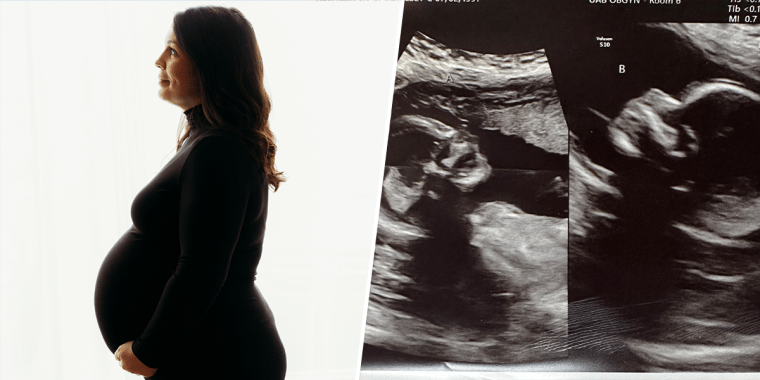A woman in Alabama who was born with a rare double uterus is pregnant in both uteri.
Kelsey Hatcher tells TODAY.com that she and her husband, Caleb, are growing their family by two in a medical anomaly. The couple are already parents to three children ages 7, 2 and 2.
Hatcher has a Didelphys uterus, meaning she has two uteri that each have their own cervix. In the spring, she discovered she was pregnant in a moment of "complete shock."
"We were done having children biologically," she recalls with a laugh. "And then when I found out I was pregnant, I was like, 'Oh, my gosh.'"
But, she says, her husband was the "greatest encourager" and was ready to take on the new journey head first — though they then received another surprise with the first ultrasound.
"She did the first ultrasound, saw the baby and said, 'Oh, everything looks great,'" Hatcher says of the procedure. "And I said, 'There’s only one baby in there, right?' I ask every time but jokingly."
Though the physician told her she only saw one baby, Hatcher reminded of her unique uterus, at which point they took another look.
"As soon as she moved the ultrasound wand across my belly, I said, 'Oh my gosh, there’s another one. Oh my gosh.' She said, 'Yes! There is,'" Hatcher recalls. "I was just in complete shock and think for the first, I don’t know, two to three weeks, my husband and I just laughed."
Dr. Shweta Patel, an OB/GYN and assistant professor in the University of Alabama at Birmingham department of obstetrics and gynecology, spoke to NBC affiliate in Alabama WVTM. She said Hatcher’s pregnancy was “very, very rare,” adding, “some OB/GYNs go their whole careers without seeing anything like this.”
Due to Hatcher’s condition, her pregnancy is still considered high-risk, according to doctors.
“A double cervix or double uterus is way under 1%, maybe three per 1,000 women might have that,” Dr. Richard Davis, who specializes in high-risk pregnancies and serves as a professor in the UAB division of maternal-fetal medicine, told the affiliate. “And then the probability of you having a twin in each horn is really crazy.”
While both of Hatcher’s daughter are growing normally and measuring the same, the difficult aspect of her pregnancy will come when they are born, whether that be together or separately.
“So when she goes into labor, if she does, then we will have to monitor each uterus and see which one’s contracting, and if they’re doing sort of almost the same or they’re different,” Davis said.
It is possible that her uteri will start contractions at different times, meaning that Hatcher’s daughters may be born apart, separated by just hours, days or even weeks.
As for whether her daughters are twins or just sisters, Patel said, “I think medically, this is such a rare thing that we don’t have a better way of describing it besides still calling them twins.”
Hatcher tells TODAY.com that she's known about her Didelphys uterus since age 17 and has since been warned of possible complications that could arise with pregnancy.
"(Doctors) were very open with me when I found out about the anomaly," she says. "Both of them are about the size of one normal uterus just split in half. And so they were very open about 'Hey, you will probably have to deal with miscarriage or preterm labor. We’ll just have to watch very closely.'"
At the time, physicians told her she may need to seek out a fertility doctor when she planned to start a family. But Hatcher says they had "absolutely no issues" getting pregnant," along with three subsequent "great" pregnancies.
"I was considered high risk during my first pregnancy, but we didn’t have any complications whatsoever," she says. "I’ve had great pregnancies since then. All three of my children so far were full-term babies — two of them actually going to 41 weeks. So yeah, all the things that (doctors) had warned me about I didn’t have to deal with. So I’m very grateful for for that."

